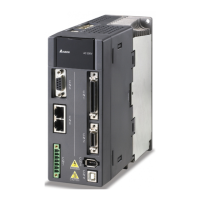Chapter 7 Motion Control ASDA-M
7-34 Revision December, 2014
established, it enters this status. The E-cam still
will not operate with the master pulse.
Engage: When it reaches pre-engaged status (path 3), it
enters this status. The E-cam starts to operate with
the master pulse.
Path Description:
Path 1:When the engaged condition is established (P5-88.Z),
the status is Stop → Pre-engaged.
The lead pulse is determined by P5-87.
Path 2:When the E-cam function is disabled (P5-88.X=0), it
returns to Stop status.
Path 3:When it is in pre-engaged status, the status is
Pre-engaged → Engaged.
Path 4:When the disengaged condition is established
(P5-88.U=4), the status is Engaged →
Pre-engaged. The lead pulse is determined by P5-92.
Path 5:When the disengaged condition is established
(P5-88.U=1,2,6), or the E-cam function is disabled
(P5-88.X=0), the status is Engaged → Stop.
Engage
Condition
P5-88.Z
When the E-cam is in Stop status, the method of determine
engaged (path 1) is as the following:
0: Engaged immediately. If P5-88.X is set to 1, the engaged
condition is established.
1: When DI.CAM is ON, the E-cam engaged.
2: From CAP to engaged: the E-cam engaged when CAP
function is enabled. After engaged, it starts to count the moving
distance. Since the CAP position is captured by hardware, it
has good instantaneity and no software delay, which is suitable
for the operating master axis before engaged.
Lead Pulse
Monitor
Variables
(061)
In pre-engaged status, the lead pulse is the moving distance
of master axis before the E-cam is engaged (path 3). Its
value decreases when input the master pulse. When the
value is 0, it enters Engaged status.
Enter Pre-engaged status via path 1, the lead pulse is
determined by the value of P5-87.
Enter Pre-engaged status via path 4, the lead pulse is
determined by the value of P5-92.
If the setting is 0, it means no lead pulse and will enter

